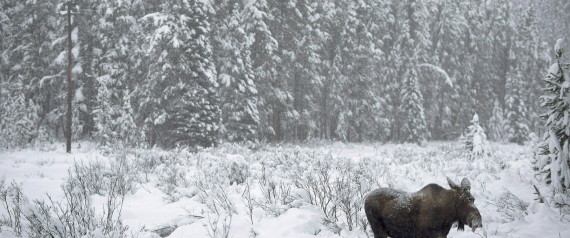Land of Plenty
"Alberta is at the front lines of boreal forest threats and issues. There are more caribou herds that are in trouble there than anywhere.
"It's basically a question of what will happen to these lands and who will decide. In so many cases it's being decided without any broad-scale thinking about what the future will look like.
"In the last ten years, it [Canada's vast heritage of boreal forests) has become known as a place just like the Amazon. Its values towards birds, towards caribou, toward carbon, toward water -- all of those things -- are really becoming much better known."
Jeff Wells, biologist, Canadian Boreal Initiative
 |
| Canadian Boreal Initiative |
The International Boreal Conservation Science Panel has named Canada's boreal forest as "the world's last great forest". This is not a designation to be taken lightly, and nor does the Government of Canada take its responsibility toward protecting Canada's huge tracts of boreal forest lightly. The huge swath of green stretching from Newfoundland to the Yukon represents Canada's famed boreal forest. And it is a unique ecosystem.
There, millions of migratory birds find their home. Endangered wildlife like caribou find shelter there in the wetlands that clean water and store carbon. The Forest Stewardship Council representing an organization promoting responsible management of the world's forests oversees the sustainable harvesting practices of trees within the boreal forest. It certifies and labels wood products from that source.
The Canadian Boreal Initiative has a mission it too takes very seriously. It has high hopes that eventually half of Canada's forest -- which represents fully one-third of the world's similar woodlands -- will be protected. That the boreal forest is gaining international prominence as a recognized resource that not only benefits Canada but the environment on a larger scale, for its carbon-capture qualities, for its natural haven for many bird and animal species can only inspire formal protection.

A moose makes its way through a snowy field near Lake Louise, Alta.
on November 23, 2012. A group of top international scientists says
Canada needs to dramatically up its conservation game to ensure its vast
northern forests remain healthy in the face of increasing industrial
pressure. THE CANADIAN PRESS/Jonathan Hayward
| CP
Given government protection at the present time is 708,000 square kilometres of the boreal forest. An additional 460,000 square kilometres is harvested through sustainable practices. The Province of Manitoba is praised for its consultation with aboriginal groups in a concerted effort to persuade UNESCO to proclaim the Pimachiowin Aki region of 33,400-square-kilometres a declared World Heritage Site.
 |
| Greenpeace |
The Government of Ontario is actively protecting half of its northern forests for posterity, as unspoiled and heritage-valued forest proudly held in protective status, despite pressure for development from the domestic mining industry in the area northeast of Thunder Bay named the Ring of Fire, and considered a valuable resource for mineral extraction at some future date. Again, consultation with First Nations is a requirement for any decision-making.
An understanding in practise that brought together environmentalists and forestry companies to work together for the purpose of ensuring that the interests of both are weighed and balanced for moderation and sustainability, having the least impact on the ecosystem of Ontario's northern forests appears to be working well, but not without some controversies that inevitably arise.

In this undated photo provided by the International Boreal
Conservation Campaign, the forest is seen after being clear cut in the
southern regions of Quebec's Boreal Forest. THE CANADIAN PRESS/AP,HO
Matt Medler
Land-use planning is seen as one of the premier challenges for governments in the coming years. Extraction of natural resources rather than conservation of valuable boreal forest values are being superimposed upon the issue of land management. As a matter of priorities, mining interests appear to be winning out in too many instances.
In an environmental stewardship assessment Canada is doing fairly well in protection of its most basic natural resource, its vast forest reserves. But the issues of development of extraction resources in mining and forestry, divesting land of its trees and minerals, one a renewable resource with proper management, the other exploiting a resource not renewable, present a need for careful decision-making.
 |
| Matt Medler/International Boreal Conservation Campaign/The Associated Press |
Labels: Biology, Bioscience, Canada, Environment, Heritage, Nature

0 Comments:
Post a Comment
<< Home